Chemistry Mobility During In Situ Remediation: What Is It and How Can You Manage It?
Chemistry mobility can be a blessing or a curse.
If you’re injecting amendments and distributing in a grid area treatment, you expect the product to move and make contact with contaminants. But if you’re utilizing a barrier treatment, mobility is the last thing you want.
On any project, it’s critical to understand chemistry mobility and your options for managing it on your project site—before you select the treatment methodology.
In this blog post, I’ll cover the types of chemistries used for in situ remediation, how mobile they are, and how you can manage chemistry mobility.
What Chemistries Are Used for In Situ Remediation?
In situ remediation involves the injection of chemistries into the subsurface to contact contaminants and destroy them through bioremediation, chemical oxidation and chemical reduction. More recently, activated carbon sequestration has been applied to overcome the challenges related to sustainable groundwater reductions.
In situ chemistries include:
- Liquids (e.g., sodium permanganate or sodium lactate)
- Solids that are soluble in water (e.g., sodium persulfate or potassium permanganate)
- Droplets (e.g., emulsified soybean oils)
- Solids (e.g., activated carbon or ZVI)
Liquids and soluble solids are injected at a design volume based on soil porosity and groundwater velocity to enhance their distribution by advective flow. Although there is some soil retention, these dilute as they move downgradient until they no longer exhibit their remediation efficacy. In some cases, liquids can be transported out of the treatment zone and foul downgradient pump and treat systems.
Droplets are smaller than the soil pore space and transport like liquids and soluble solids. However, they eventually stick to the soil and their transport is somewhat limited outside of the radius of influence, making them better suited for grid or barrier injection.
Solids fall into two categories:
- Smaller than the soil pore size (often called colloidal)
- Larger than the soil pore size
Colloidal solids will inject like liquids, but the other solids will require fracturing the soil to open flow paths. Though many have tried, the latter can’t be distributed at low pressures and flow rates. Typically, these chemistries are applied to finer-grained soils or trenched into shallower target intervals. This avoids injection challenges related to fracturing solids in coarse-grained soils and short-circuiting at shallow depths.
How Mobile Are These Chemistries?
Liquids, colloidal solids, and dissolved solids are very mobile — so they are unsuitable for reactive barrier applications versus the larger solids. With average groundwater velocities, they will flush out of the barrier zone, become diluted, and not provide an effective barrier.
While there will be a reactive zone down gradient of the barrier, the ratio of contaminant molecules to chemistry molecules will be increased, and the likelihood of contact in the barrier will be reduced. Considering that many barrier locations, especially at property lines, are designed to meet stringent groundwater levels (e.g., 5 ppb for TCE or an expected 4 ppt for PFAS), keeping these chemistries within the barrier is a key component of their application.
In some cases, but not often, successful recirculation wells keep the liquid and dissolved solid chemistries within the barrier. However, this adds extra cost, and in some cases, these recirculation wells can be fouled by the chemistries themselves or bacterial activity associated with them.
This leaves colloidal solids and specifically activated carbon, which typically averages 3 um in size. These chemistries were developed to overcome the challenges of fracturing powdered activated carbon (PAC @ 25 um). The good news is their mobility provides for lower pressure and flow injection for effective distribution and complete coverage. Unfortunately, their mobility will allow them to flow outside the barrier location.
As with all in situ chemistries, they are constantly being developed and optimized as field application issues are better understood. That’s the case with Cascade’s ColloidalChem +AnchorTM, a patented enzyme technology that can be simultaneously injected reduced mobility. This allows ColloidalChem to be immobilized while in the defined barrier location where contact is required needs to be isolated.
Here’s how it works:
- A remediation colloid stabilized by non-toxic biopolymer is injected into the subsurface, mixing with a slow-acting enzyme.
- After injection, the enzyme breaks down the stabilizing polymer, rendering the remediation chemical particles immobile.
The figure below demonstrates the anchoring capabilities versus injection of highly mobile colloidal activated.

Colloid immobilization offers other benefits, too. This approach allows for rapid restoration of groundwater quality, and prevents particles from entering downgradient wells and interfering with closure monitoring or requiring the installation of new wells.
With a better understanding of the mobility of the chemistries used during in situ remediation, you’ll be better prepared to start your next project.
If you’re interested in learning more about mobility when treating groundwater plumes, watch our on-demand webinar, PFAS 102: Plume Treatment.












